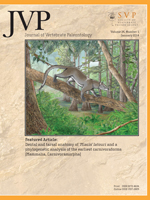The Lumbrera Formation is an Eocene unit cropping out in northwestern Argentina from which three cichlid species were recently described and represent the oldest Neotropical cichlid records: Proterocara argentina, Gymnogeophagus eocenicus, and Plesioheros chauliodus. The fossils come from a level interpreted as a perennial, low-energy, freshwater lake surrounded by low relief and sporadically flooded vegetated areas. Sedimentological, paleontological, and absolute U/Pb zircon dating studies suggest a lower Eocene age (∼48.6 Ma). Phylogenetic analyses place these cichlids as nested in the modern Geophagini and Heroini clades and attest to early differentiation from the basal cichlid lineages and a morphological conservatism since at least the early Eocene (∼48.6 Ma). Molecular phylogenies calibrated with the Lumbrera Formation fossils suggest that the age of cichlids may be considerably older than the minimum age provided by currently known fossils. In combination with well-established family-level phylogenetic relationships compatible with Gondwanan fragmentation, the origin of the Cichlidae likely dates back to the Cretaceous. The occurrence of Eocene cichlid fossils in the same geographical area as that of related modern lineages suggests that patterns of distribution and endemism of the Neotropical Cichlidae have an ancient history. Here we describe additional cichlid specimens from the Lumbrera assemblage and evaluate their implications for cichlid phylogeny and paleobiogeography.
How to translate text using browser tools
1 January 2014
On the Eocene Cichlids from the Lumbrera Formation: Additions and Implications for the Neotropical Ichthyofauna
Maria C. Malabarba,
Luiz R. Malabarba,
Hernán López-Fernández
ACCESS THE FULL ARTICLE





